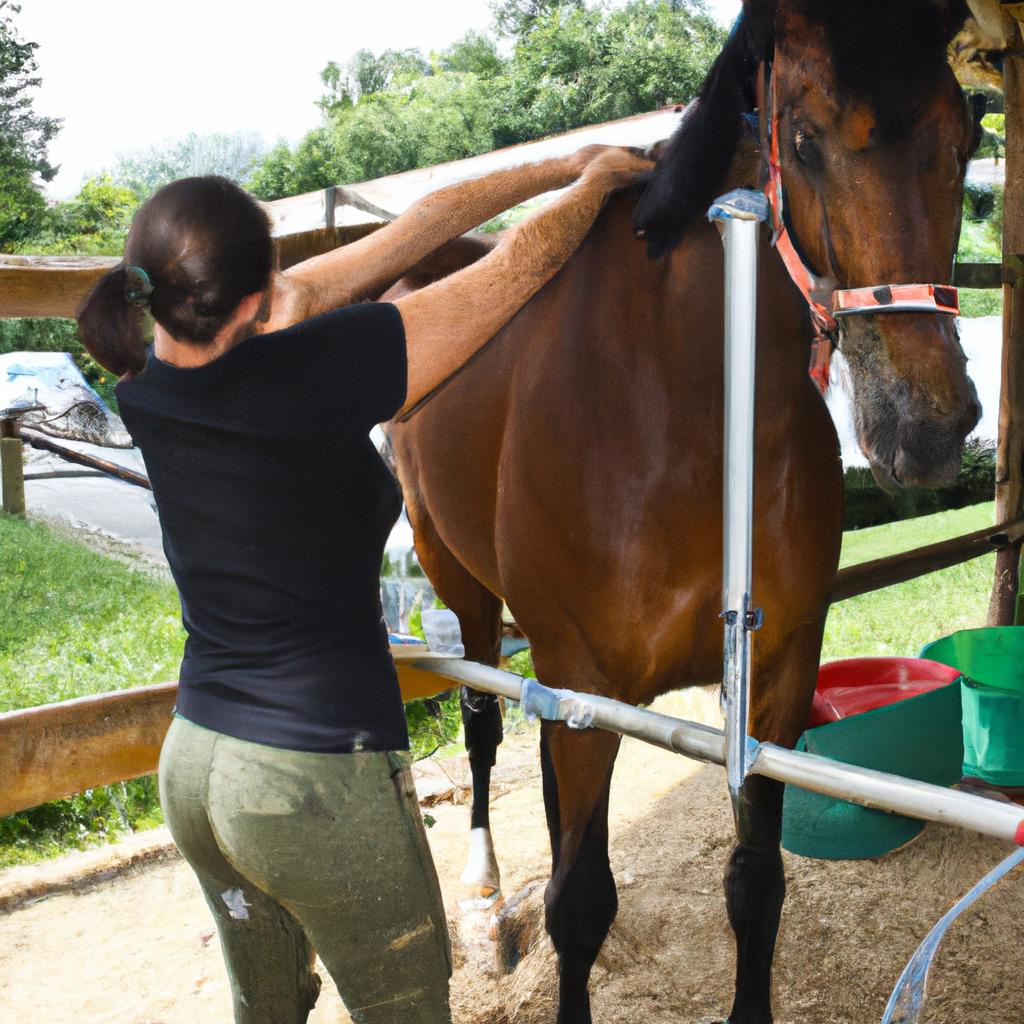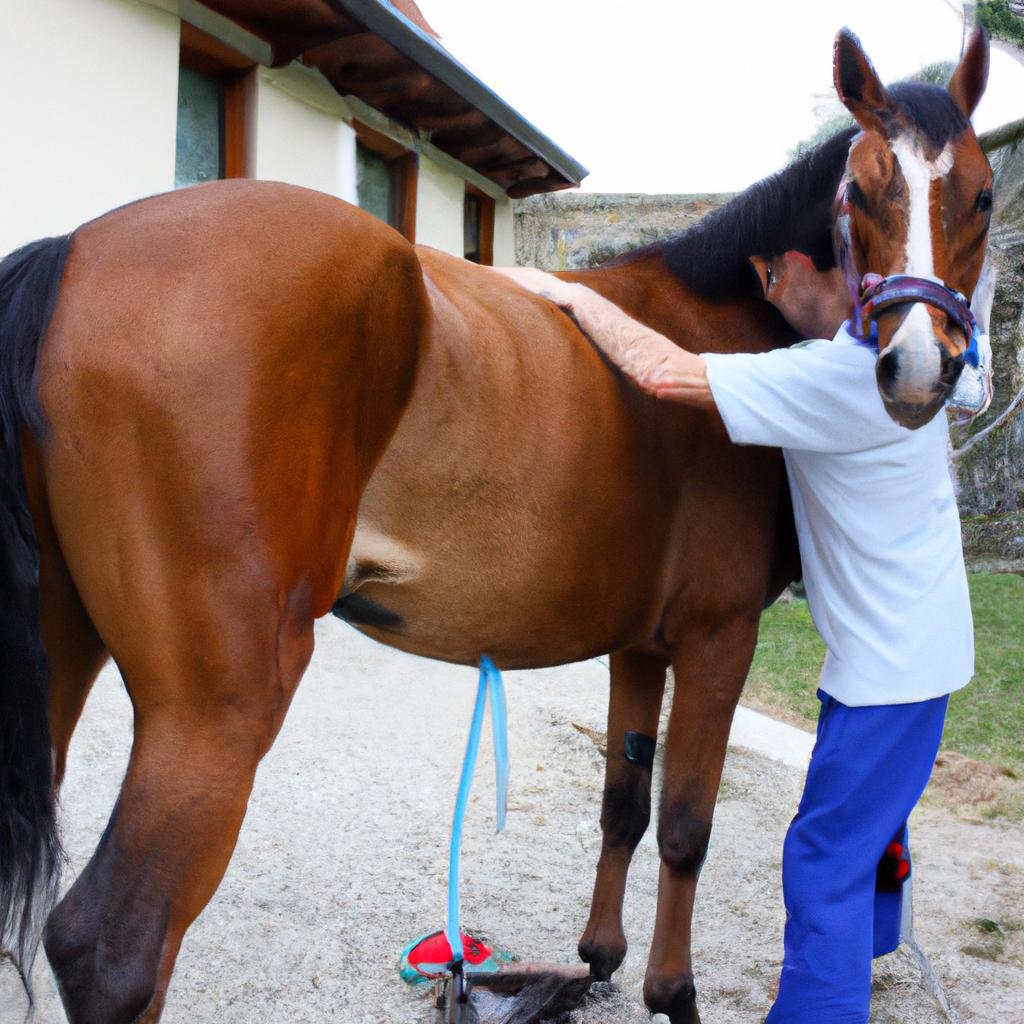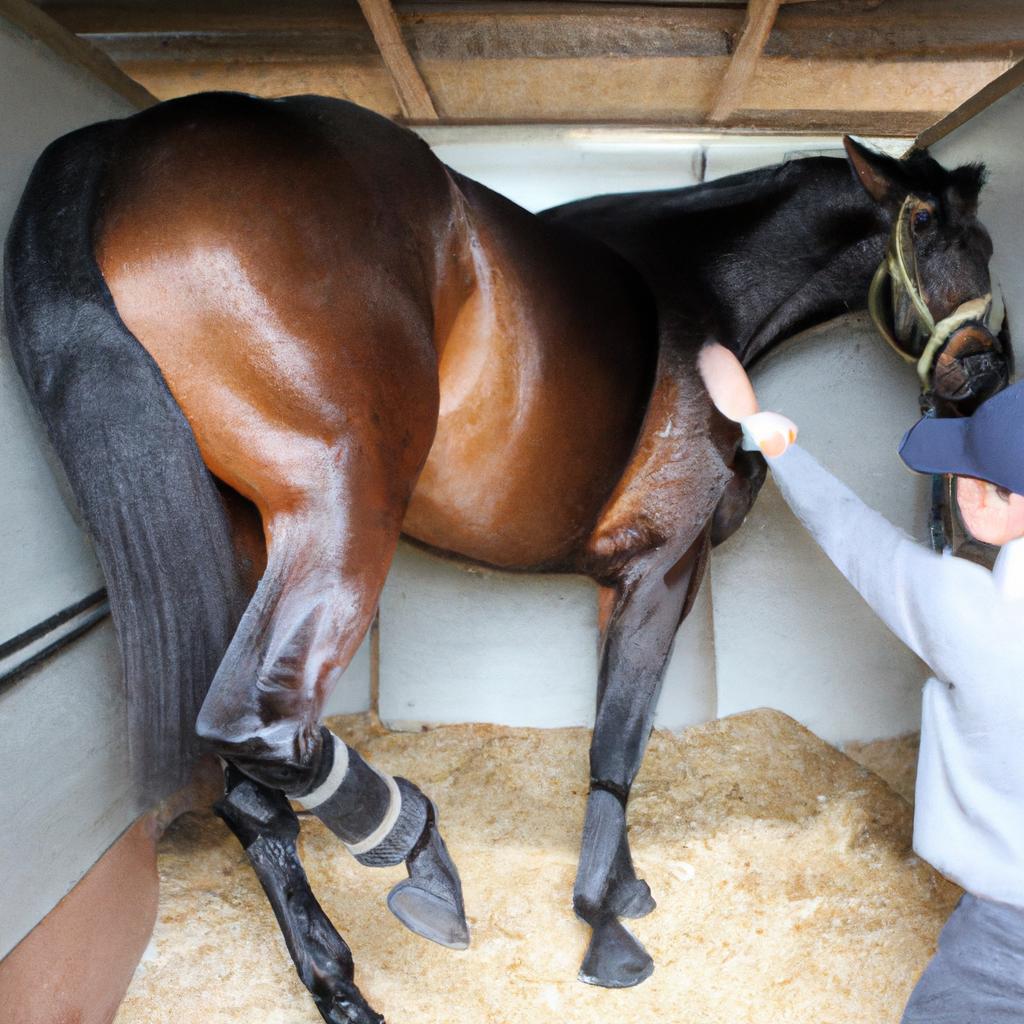Gait abnormalities in horses can be a significant concern for owners and trainers alike. These conditions not only affect the horse’s performance but also their overall well-being. Understanding the common conditions that contribute to gait abnormalities is essential in developing effective treatment strategies. This article aims to explore the various gait abnormalities observed in horses and how chiropractic care can be used as an alternative therapy to address these issues.
One compelling example of a gait abnormality is seen in horses diagnosed with lameness caused by osteoarthritis. Osteoarthritis, commonly known as degenerative joint disease, affects the articular cartilage within joints, leading to pain, stiffness, and restricted movement. Horses suffering from this condition often exhibit altered gaits characterized by uneven strides or shortened steps. Such changes significantly impact their ability to perform tasks such as jumping or racing effectively. Exploring the potential benefits of chiropractic care in managing this specific gait abnormality could provide valuable insights into its efficacy for other similar conditions.
In recent years, there has been growing interest in using chiropractic techniques as part of comprehensive equine healthcare protocols. Chiropractic care focuses on diagnosing and treating musculoskeletal disorders through manual manipulation of the spine and other related structures. By By applying specific adjustments to the horse’s spine and joints, chiropractors aim to restore proper alignment, improve joint mobility, and alleviate pain. In the case of gait abnormalities caused by osteoarthritis, chiropractic care can help address the underlying musculoskeletal imbalances that contribute to altered gaits.
Chiropractic adjustments can release restrictions in the affected joints, reduce inflammation, and improve overall joint function. This can lead to improved range of motion and flexibility, allowing the horse to move more freely and comfortably. By addressing these underlying issues, chiropractic care may help minimize the compensatory movements that horses with gait abnormalities often adopt.
Furthermore, chiropractic care can also have a positive impact on the horse’s nervous system. Misalignments in the spine can interfere with proper nerve function, leading to abnormal muscle firing patterns and coordination problems. By correcting these misalignments, chiropractic adjustments may enhance neural communication between the brain and body, facilitating better motor control and coordination.
It is important to note that while chiropractic care can be beneficial for managing gait abnormalities in horses caused by musculoskeletal disorders like osteoarthritis, it should not replace traditional veterinary care. A comprehensive approach that includes regular veterinary check-ups, diagnostics, and appropriate medical interventions should always be pursued alongside alternative therapies like chiropractic care.
In conclusion, gait abnormalities in horses can significantly impact their performance and well-being. Chiropractic care offers a non-invasive alternative therapy option that focuses on restoring proper alignment and function of the musculoskeletal system. By addressing underlying musculoskeletal imbalances and enhancing neural communication, chiropractic adjustments may help manage gait abnormalities caused by conditions like osteoarthritis. However, it is crucial to consult with a qualified equine chiropractor who has experience working with horses to ensure safe and effective treatment.
Overview of Gait Abnormalities in Horses
Imagine a horse named Bella, an otherwise healthy and active mare who starts exhibiting an unusual way of moving. Her gait becomes irregular, with noticeable limping and stiffness. This is just one example of the many gait abnormalities that horses can experience, which can significantly impact their overall health and performance.
Gait abnormalities in horses refer to any deviation from a normal walking or running pattern. These deviations may arise from various sources, such as biomechanical issues, musculoskeletal disorders, or neurological conditions. Identifying and understanding these abnormalities are crucial for veterinarians and equine professionals to provide appropriate care and treatment.
To better comprehend the complexity of gait abnormalities in horses, consider the following four key factors:
- Biomechanics: The study of how forces affect movement in living organisms.
- Musculature: The muscular system’s role in generating power and facilitating locomotion.
- Skeletal structure: How bone alignment impacts stability and coordination during movement.
- Neurological control: The nervous system’s influence on coordinating muscle contractions and maintaining balance.
By examining these factors together, we gain insight into how alterations within each component can lead to gait abnormalities. To illustrate this further, let us take a closer look at a hypothetical case involving Bella:
| Case Study: Bella | |
|---|---|
| Age | 8 years old |
| Discipline | Dressage |
| Complaint | Left hind limb lameness |
Bella presents with left hind limb lameness during dressage training sessions. As her owner noticed her performing lateral movements less effectively than before, they sought veterinary evaluation. Through careful examination and diagnostic tests, it was determined that Bella had developed sacroiliac joint dysfunction—a condition affecting the lower back region—that caused asymmetrical weight-bearing patterns leading to her abnormal gait.
Understanding the role of chiropractic care in addressing gait abnormalities is crucial. By focusing on restoring proper musculoskeletal alignment and optimizing neurological control, chiropractors can help horses like Bella regain their natural gait patterns. In the subsequent section, we will explore how chiropractic interventions contribute to equine rehabilitation and performance enhancement, ultimately improving overall horse welfare.
Now let us delve into understanding the role of chiropractic care in treating gait abnormalities in horses without further delay.
Understanding the Role of Chiropractic Care
Gait abnormalities in horses are a common concern among horse owners and veterinarians alike. These conditions can range from mild to severe, causing discomfort and affecting the overall performance of the animal. Chiropractic care has emerged as an effective treatment option for managing gait abnormalities in horses, offering a holistic approach that targets the underlying issues contributing to the problem.
To illustrate the benefits of chiropractic care in addressing gait abnormalities, let’s consider a hypothetical case study. Imagine a competitive show jumper experiencing recurrent lameness during training sessions. Despite traditional veterinary treatments, such as anti-inflammatory medications and rest periods, the horse continues to exhibit signs of discomfort while performing certain movements. In this scenario, seeking chiropractic care could help identify any misalignments or joint restrictions that may be contributing to the abnormal gait pattern.
Chiropractic care for horses with gait abnormalities focuses on restoring proper alignment and function of the musculoskeletal system. By employing specific manual adjustments, chiropractors aim to alleviate tension or pressure on affected joints, muscles, ligaments, and nerves. This non-invasive approach not only improves range of motion but also enhances proprioception and coordination – crucial factors influencing gait quality.
Understanding the role of chiropractic care in managing gait abnormalities is essential for both horse owners and veterinarians. Here are some key points highlighting its significance:
- Chiropractic adjustments can target specific areas of dysfunction within the musculoskeletal system.
- The holistic nature of chiropractic care addresses potential root causes rather than just symptom management.
- Regular chiropractic maintenance can prevent future gait abnormalities by promoting overall musculoskeletal health.
- Collaboration between veterinarians and equine chiropractors ensures comprehensive healthcare for horses exhibiting gait irregularities.
Through incorporating regular chiropractic evaluations into their equine healthcare routine, horse owners can optimize their animals’ well-being and potentially enhance their performance abilities.
| Benefits | Treatment Options | Potential Outcomes | Collaborative Approach |
|---|---|---|---|
| Improved gait quality | Manual adjustments | Enhanced performance | Veterinarian-Chiropractor collaboration |
| Pain relief | Soft tissue therapies | Increased range of motion | Comprehensive healthcare planning |
| Better coordination and proprioception | Rehabilitation exercises | Prevention of future abnormalities | Holistic treatment approach |
| Overall musculoskeletal health promotion | Nutritional support | Long-term soundness | Combined expertise for optimal outcomes |
Transitioning into the subsequent section about diagnosing gait abnormalities in horses, it is crucial to explore various diagnostic techniques used by veterinarians to identify the underlying causes contributing to these conditions. By thoroughly assessing a horse’s gait and employing advanced imaging technologies, accurate diagnoses can be made, paving the way for targeted treatment plans tailored to each individual animal’s needs.
Diagnosing Gait Abnormalities in Horses
Understanding the Role of Chiropractic Care in Managing Gait Abnormalities
To illustrate the effectiveness of chiropractic care in treating gait abnormalities in horses, let us consider an example. Imagine a 10-year-old Thoroughbred mare named Bella who has been displaying signs of asymmetrical movement and difficulty transitioning between gaits. After a thorough examination, it is determined that Bella’s abnormal gait is caused by misalignments in her spinal vertebrae and pelvis. This case study highlights one common condition where chiropractic intervention can play a crucial role in restoring normal gait patterns.
Chiropractic care offers several benefits for horses with gait abnormalities. Firstly, it helps to improve joint mobility by reducing restrictions caused by misalignments. Secondly, it aids in relieving muscle tension and promoting proper biomechanics throughout the horse’s body. Thirdly, chiropractic adjustments can enhance nerve function and communication between different parts of the musculoskeletal system. Lastly, regular chiropractic sessions can help prevent future injuries or worsening conditions by maintaining optimal spinal alignment.
Evidently, various techniques are employed within equine chiropractic care to address gait abnormalities effectively. These techniques may include but are not limited to:
- Manual adjustment: Skilled practitioners use their hands to apply controlled forces to specific joints or areas of the spine.
- Instrument-assisted manipulation: Specialized tools like activators or impulse adjusters are used to deliver precise adjustments without excessive force.
- Soft tissue therapy: Therapeutic massage techniques are employed to release tension in muscles surrounding affected joints.
- Rehabilitation exercises: Tailored exercise programs aim to strengthen weak muscles and improve coordination.
In summary, chiropractic care plays a vital role in managing gait abnormalities in horses such as Bella. By addressing underlying structural issues through manual adjustments, instrument-assisted manipulation, soft tissue therapy, and rehabilitation exercises, veterinarians and experienced practitioners help restore proper biomechanics, enhance joint mobility, and improve overall gait function. In the upcoming section, we will delve into specific chiropractic techniques used to alleviate gait abnormalities in horses.
Specific Chiropractic Techniques for Gait Abnormalities
Gait abnormalities in horses can stem from a variety of underlying conditions. One such condition is laminitis, which causes inflammation and damage to the sensitive laminae within the hooves. This can result in an altered gait pattern characterized by short strides and increased weight shifting between limbs. Lameness due to laminitis can be effectively addressed through chiropractic care.
A key aspect of diagnosing gait abnormalities in horses is assessing their movement patterns and identifying any deviations from normal locomotion. Veterinarians and equine chiropractors employ various methods for this purpose, including visual observation, palpation, flexion tests, and diagnostic imaging technologies like radiography or ultrasound. By carefully evaluating the horse’s gait and conducting thorough examinations, practitioners can pinpoint the specific areas that require attention.
Specific chiropractic techniques have been developed to address gait abnormalities in horses with precision and effectiveness. These techniques aim to restore proper alignment and mobility within the horse’s musculoskeletal system, promoting optimal function and reducing pain or discomfort associated with abnormal gaits. Common chiropractic interventions include spinal adjustments, joint mobilizations, soft tissue therapies, stretching exercises, and rehabilitative measures tailored to each individual case.
Chiropractic care offers several benefits for horses experiencing gait abnormalities:
- Pain relief: By addressing misalignments or restrictions within the horse’s spine and joints, chiropractic adjustments help alleviate pain caused by gait abnormalities.
- Improved range of motion: Chiropractic techniques enhance joint flexibility and muscle balance, allowing for smoother movements during locomotion.
- Enhanced performance: Correcting biomechanical imbalances through chiropractic care can optimize a horse’s overall athletic ability.
- Holistic approach: Chiropractors consider not only the affected area but also other parts of the body that may contribute to gait abnormalities, providing comprehensive treatment.
| Condition | Symptom | Treatment |
|---|---|---|
| Laminitis | Short strides | Spinal adjustments |
| Weight shifting | Joint mobilization | |
| Soft tissue therapy | ||
| —————— | ——————– | ——————— |
| Tendonitis | Limping | Stretching exercises |
| Swelling | Rehabilitation | |
| measures | ||
| —————— | ——————– | ——————— |
| Arthritis | Stiffness | Spinal adjustments |
| Reduced range of | Joint mobilization | |
| motion | Soft tissue therapy | |
In summary, diagnosing gait abnormalities in horses requires a comprehensive evaluation of their movement patterns and identification of any underlying conditions. Chiropractic care offers specific techniques that can effectively address these abnormalities by restoring proper alignment and mobility within the horse’s musculoskeletal system. By alleviating pain, improving range of motion, enhancing performance, and adopting a holistic approach to treatment, chiropractic care provides significant benefits for horses experiencing gait abnormalities.
Moving forward from addressing gait abnormalities through chiropractic care, let us now explore how this form of treatment can be beneficial in treating lameness in horses.
Treating Lameness in Horses with Chiropractic Care
Having explored the various chiropractic techniques employed to address gait abnormalities in horses, it is now essential to delve into the effective treatment of lameness through chiropractic care. To illustrate the efficacy of such treatment, consider a hypothetical case study involving a dressage horse exhibiting signs of hind limb stiffness and reduced flexibility during lateral movements.
Case Study:
In this hypothetical scenario, a 9-year-old dressage horse named Bella presented with decreased range of motion and asymmetrical movement patterns while performing lateral exercises. Upon thorough evaluation, it was determined that Bella’s condition could be attributed to subluxations along her vertebral column affecting nerve function and muscle coordination. Through specific chiropractic adjustments targeting these subluxations, Bella’s mobility gradually improved over several sessions, resulting in enhanced performance and increased comfort.
To further understand how chiropractic care can effectively treat lameness in horses, consider the following key points:
- Restoring Alignment: By correcting misalignments or subluxations within the spinal column, chiropractors help restore proper joint mechanics and alleviate stress on surrounding tissues.
- Enhancing Nerve Function: Improved alignment facilitates optimal nerve communication between the brain and body, allowing for more efficient muscle activation and coordination.
- Promoting Circulation: Manipulative therapies utilized by chiropractors stimulate blood flow to affected areas, providing vital nutrients required for tissue repair and reducing inflammation.
- Facilitating Overall Wellness: Regular chiropractic treatments not only target existing issues but also support overall well-being by enhancing musculoskeletal health and promoting better biomechanical functioning.
| Key Benefits of Chiropractic Care for Lameness in Horses |
|---|
| Restores alignment and joint mechanics |
| Enhances nerve function and muscle coordination |
| Promotes circulation for tissue repair |
| Facilitates overall wellness |
Understanding the benefits of chiropractic care in treating lameness is crucial, but preventing gait abnormalities from occurring altogether is equally important. In the subsequent section, we will explore preventive measures to maintain a healthy gait in horses without compromising their performance or well-being.
Preventive Measures to Maintain Healthy Gait in Horses
Lameness is a common issue among horses, which can significantly affect their overall performance and well-being. While there are various treatment options available, chiropractic care has emerged as an effective approach for addressing gait abnormalities in these majestic animals. By utilizing manual adjustments and manipulations, chiropractors aim to alleviate pain, improve joint mobility, and restore proper alignment of the musculoskeletal system.
One example that highlights the effectiveness of chiropractic care in treating lameness in horses involves a 10-year-old Thoroughbred racehorse named Thunderbolt. Thunderbolt had been experiencing recurrent episodes of lameness, resulting in decreased performance on the track. After thorough examination by a veterinarian and consultation with a chiropractor specializing in equine care, it was determined that Thunderbolt’s gait abnormalities were primarily caused by misalignments in his spinal column.
Chiropractic care offers several benefits for horses suffering from gait abnormalities:
- Pain relief: Manual adjustments performed by skilled chiropractors help relieve pain associated with musculoskeletal conditions such as arthritis or ligament strains.
- Improved range of motion: By restoring proper alignment of joints and reducing muscular tension, chiropractic treatments enhance the horse’s flexibility and range of motion.
- Enhanced athletic performance: Addressing gait abnormalities through chiropractic care enables horses to move more efficiently, leading to improved speed, agility, and endurance.
- Holistic approach: Chiropractic care focuses on identifying underlying causes rather than simply alleviating symptoms. This comprehensive approach ensures long-term improvement rather than temporary relief.
Table: Comparing Treatment Options for Gait Abnormalities in Horses
| Treatment Option | Benefits | Limitations |
|---|---|---|
| Chiropractic Care | – Provides pain relief\n – Improves range of motion\n – Enhances athletic performance\n – Takes holistic approach | – Requires skilled practitioners\n – May not be suitable for certain conditions |
| Medication | – Provides temporary relief from pain and inflammation\n – Available in various forms (oral, injectable) | – Does not address underlying causes\n – Potential side effects with long-term use |
| Physical Therapy | – Strengthens muscles and improves flexibility\n – Helps rehabilitate injured horses | – Requires regular sessions to maintain benefits\n – Not effective for all gait abnormalities |
In conclusion, chiropractic care offers a promising treatment option for horses suffering from gait abnormalities. Through manual adjustments and manipulations, this holistic approach can provide significant pain relief, improve range of motion, enhance athletic performance, and target the root causes of lameness. While it is essential to consult with qualified professionals before implementing any treatment plan, chiropractic care has shown considerable potential in improving the overall well-being and quality of life for horses experiencing gait abnormalities.
 Eq Muscle Release
Eq Muscle Release



